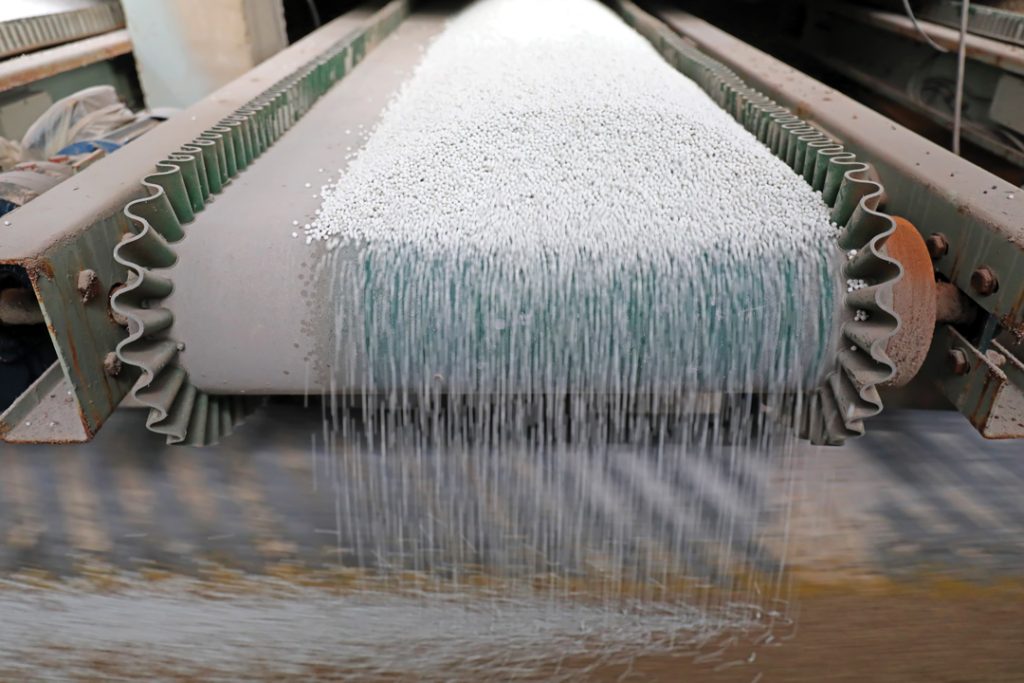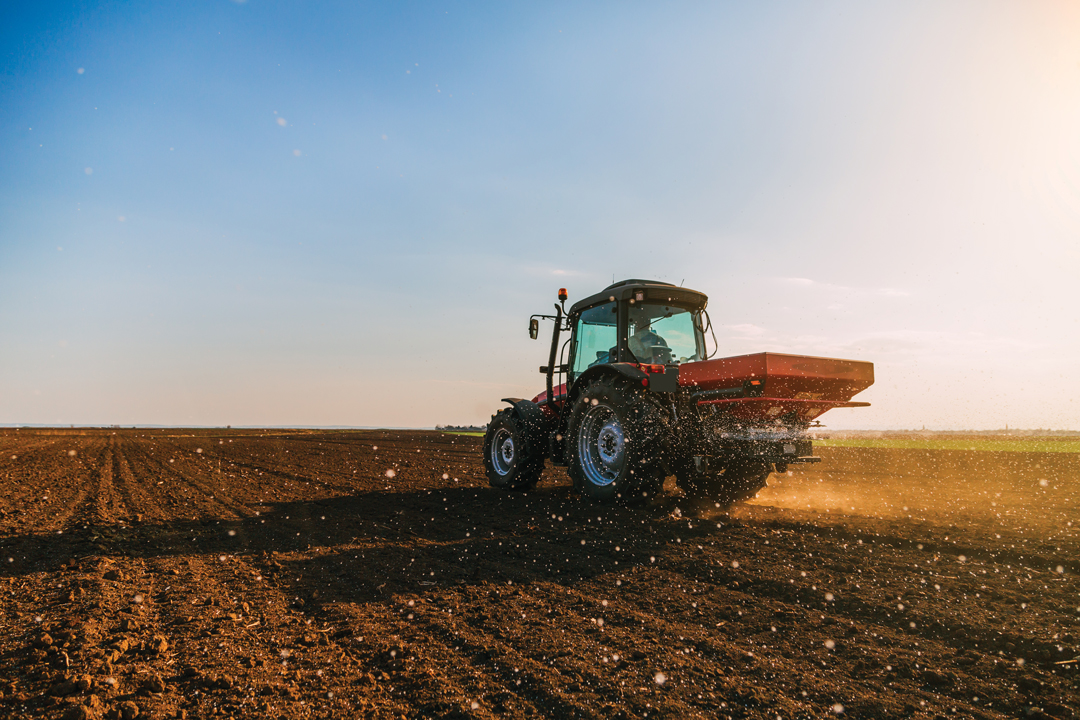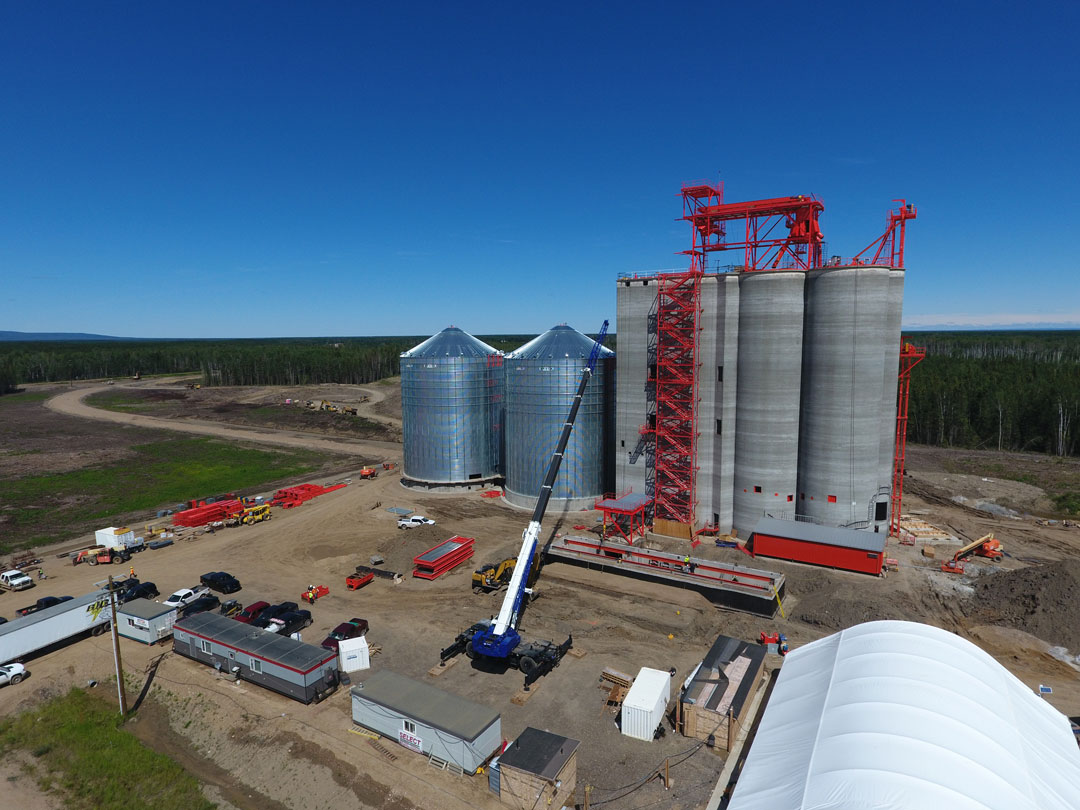FERTILIZER FEVER
BY TREVOR BACQUE • PHOTOS: SHUTTERSTOCK
What goes up must come down, unless it continues to go up.
That about sums up the tale of fertilizer over the last two years. After all, it was only two years ago in Western Canada that urea sold at $400 per tonne. That was the beginning of the end of low prices. Many forces have been at play as the state of flux in the world of fertilizer continues to take farmers on a wild ride whether they want to take the trip or not. With so much at stake, and with prices so high, many wonder when will things “go back to normal?” After such a prolonged period of uncertainty, perhaps this is normal.
The summer of 2020 got off to a good start, especially across the Midwest U.S., where about one third of the global corn and soybean supply is grown. That changed on Aug. 10, 2020. Weeks out from harvest, a violent 14-hour storm known as a derecho travelled some 1,200 kilometres through six states with Illinois, Indiana and Iowa being the hardest hit. The brutal weather event that tore over the landscape was the first of many dominoes to fall in the madness that is today’s fertilizer marketplace.
One of the world’s foremost fertilizer marketing experts, Josh Linville of StoneX Group fingered the derecho as the absolute catalyst for the current state of affairs. “That caused grain prices to go from very, very low to very, very high,” he said. “Demand went from non-existent before that event to phenomenal.”
From there, farmers’ fertilizer demands soared due to the influx of cash and week after week grain prices climbed steadily to record levels for virtually all crops. The spring of 2021 was strong and demand for inputs did not waver, nor did their prices. Fertilizer companies drew down inventories to some of the lowest levels on record, noted Linville.
As crop prices remained bullish, fertilizer likewise began to trend upward. In June 2021, the price of urea sold by Prairie retailers crested above $600. Simultaneously, tensions mounted between Russia and Ukraine throughout that year. This led to rising European energy production and prices that were eventually labelled a crisis by market analysts. By September, local prices hit $900. That same month, Chinese officials blinked and took swift measures to protect its sovereignty. As the world’s largest phosphorus producer, it stopped all exports overnight. The government said it was necessary to preserve domestic supply for its own farmers and that restrictions would lift on June 30, 2022. The country never resumed normal levels, but eventually implemented an export quota system that will see steep declines in annual tonnage moved to other nations until at least 2023.
Meanwhile, Linville continued to observe the flurry of weather-, production- and conflict-related activity that sent markets severely out of balance. “It wasn’t one action that caused prices to go sky-high, so it’s not going to be one action to cause prices to go way back down to where they were,” he said.

Overall, the global economics of fertilizer have been a tremendous benefit for North American natural gas producers. Despite recent price increases, production costs of natural gas remain low enough that margins are big. “They jumped up [USD] $6, $7, $8, $9, but that is still very, very low on our cost of production versus what they’ve been able to sell it for,” he said. He added it has also helped Persian Gulf nations where natural gas is a byproduct of oil production. Natural gas prices in Europe had jumped to more than USD $80 and Asia hit above USD $65 as recently as late August 2022.
But for every winner, there’s always a loser and farm retailers shoulder a disproportionate amount of risk during these nervy times. Linville notes retailers constantly walk a fine line between buying lower and selling higher. This has become a massive challenge when price predictability is nearly impossible and, “That puts them in a very unique and dangerous situation.”
If it sounds a bit hyperbolic, Brad Hanmer, owner of Synergy AG, confirms it’s really not. The agri-retailer owns and operates 11 locations, ten in Saskatchewan and one in Alberta. He said during his farming and business career he hasn’t witnessed anything like what’s taken place since 2020. It’s caused him more stress from both a corporate and personal perspective.
“Farmers were a lot more affected than the retailers allowed them to realize because we took a lot of that shock absorption,” he said. “It was very scary. I’ve had many sleepless nights.”
There have been many factors that have led to various supply chain problems, from the pandemic through to natural gas production issues and geopolitical tension. The biggest factor that has kept Hanmer’s business afloat is simply good customer relations, which eased uncertainty during an already strenuous time.
Hanmer said creating a true partnership as a trusted advisor is the way to navigate uncertainty and the volatility of the supply channel. “We find our advantage is to listen to our customers,” he said. “Retailers are just going to have to be nimble and understand the needs of their customers and act way faster than they’ve ever acted before.”
He labels agriculture as a “resilient” industry that always ends up on the right side of history, but knows it is going to take more lumps than usual. “It’s just a matter of how scraped and beaten up are we going to be? The new norms have yet to be rewritten. In the last 24 months, it’s only gotten more uncertain.”
At Synergy, the typical business plan was to create a yearly fertilizer outlook for its buying needs, but Hanmer said he is now rejigging the lookout sometimes weekly due to the fluidity of the situation. This means perpetually managing product flow and farmers’ expectations, both a constant challenge.
It’s not as though farmers are unaware of the situation, or the economics behind it. Craig Klemmer, Farm Credit Canada principal economist, stated the obvious that just as input costs are rising, so, too, are crop prices. This includes record highs for multiple commodities, including canola, 21.4 million acres of which went into the ground this past spring.
“For those that get a good crop this year, we expect a strong year financially for grains and oilseed producers,” he said. In effect, if both inputs and prices are up—or down—at the same time, farmers will not drastically change how they conduct business.
“As long as commodity prices are increasing, you are not going to see a significant change in behaviour unless that comes with some technological improvements that are easily adaptable and improve overall farm economics in general,” he said. “Farmers need crop inputs. You’re not going to see them cutting fertilizer application rates too much. They might play with them a little bit year to year. They’re going to be looking at getting the most production they possibly can. That means applying fertilizer. It might accelerate some of the technology we use into VR application.”
While this remains to be seen, it does not negate that this year’s crop is likely the most expensive in history when measured by input costs. Klemmer believes crop insurance and farmer programs will continue to be a help for those in need. For the foreseeable future, he expects fertilizer prices to follow corn in a linear fashion. “We’ve always seen that relationship,” he said. “In time, the expectation, or hope, is we see easing of the energy prices and have some supply built and developed.”
Part of this supply increase will come domestically. KSPC announced in May it will double its production at Bethune, SK, to a total of four million tonnes. Mosaic plans to add another 1.5 million tonnes of potash production by the second half of 2023 at two Saskatchewan mines in Esterhazy and Colonsay. Nutrien, the world’s largest potash producer, pledged to increase potash production by five million tonnes to a total of 18 million by 2025. The company is also keenly interested in moving into clean ammonia production, which would align with fertilizer emission reductions programs popping up in many countries.
“We’re doing what we can to add production to meet the global need,” said Jason Newton, Nutrien’s chief economist. “There are constraints to how fast you can do that.”
Similarly, CF Industries in the U.S. is increasing liquid nitrogen exports on both coasts to help relieve sourcing issues globally.
While supply is built up, there are few workarounds and certain countries had no choice recently but to conduct business with Vladimir Putin. After all, what’s Canada’s favourite Russian import? “It’s not vodka. It’s fertilizer,” said Karen Proud, CEO of Fertilizer Canada. “No matter how one feels about Russia, the reality is Canada relies on Soviet fertilizer, especially those Ontario-east.”
This reality sunk in on March 3, 2022. That day Canada stripped both Russia and Belarus of Most Favoured Nation status, and subjected both countries to an eye-popping 35 per cent tariff on virtually all goods entering the country, joining a nefarious directory that had previously only included North Korea. To date, Canada is the only country to apply such tariffs on Russian and Belarussian goods. What truly stings, though, is farmers were hit with the 35 per cent tariff despite having already bought their fertilizer at a contracted price, some as far back as July 2021, well before the levy was announced. Research from the Grain Farmers of Ontario and RealAgristudies discovered farmers in Eastern Canada were collectively hit with more than $150 million in extra charges on fertilizer they already purchased.
The timing is tight, too. Since Russian fertilizer comes up the St. Lawrence River after spring thaw, the window is limited and the 660,000 tonnes that came in last year and represent anywhere from 85 to 90 per cent of all fertilizer used in the East. Western Canadian farmers did not suffer the same detrimental effects of the tariffs, but they’ve still paid unheard-of prices. The price of urea was around $1,200 per tonne in early October.
“Nobody thinks about fertilizer until you don’t have enough,” said Proud. “Well, this is the time where everybody is concerned, and rightly so.” When the government put forward the sanctions, there wasn’t a full appreciation of the impact on fertilizer. I don’t believe they really understood how much is used in Eastern Canada, the way it’s procured and the timing. It’s not like we’re sitting on top of all this extra reserve.”
Proud noted Canada is doing “all that it can” when it comes to increasing production, but it’s not as easy as flipping a light switch. “Our facilities operate seven days a week, 24 hours a day. There’s not that extra capacity.”
As the world’s No. 1 potash producer, Canada is in a unique, resource-rich position, to step into the gap left by Belarus and Russia. However, the difficulty lies with those in Ottawa recognizing the value of fertilizer. Proud said lately it feels as though the sector she represents is not being taken seriously.
“I don’t think the government really sees the fertilizer industry as the huge success it is and the potential for this industry to grow and really thrive. I don’t know why that is,” she said. “It may be that people don’t think about fertilizer, it’s not top of mind. It’s not a politically sexy industry.”
Proud and her team have met with representatives of many nations, including Japan, Italy, Brazil, all wanting a Canuck solution. “There’s huge demand out there and the answer is Canadian fertilizer.”
To date, Fertilizer Canada members are simply trying to secure sufficient supply to avoid the headaches of last spring. Despite supporting the government’s actions to stop the situation in Ukraine from further escalation, Proud insists such taxation is not the answer. “We’ve always maintained that fertilizer is a humanitarian product to feed the world,” she said. “We feel that it should never be subject to sanctions.”
Everyone can agree fertilizer is a non-negotiable product farmers require to produce food the world over. As everyone has witnessed, what happens in one country produces ripple effects well beyond its borders.
Linville underscores the importance of patience and perspective by likening the supply chain to a mallard. “The farmer just sees a duck gliding effortlessly across the lake. They don’t see that duck underneath the water kicking like hell trying to get from point A to point B. What they don’t see underneath the surface is the trucking, the rail, the barge, the global vessel, the price risk.
“Ultimately, something that happens with Russia–Ukraine matters here. We’re part of a world economy whether we want to believe it or not. The farmer is starting to get more educated and more aware of that, but it’s a long process. It’s a generational way of thinking that’s going to be changed and it’ll get there, it just takes time.”
Dominoes of fertilizer market madness
Various factors have led to record-high demand and prices for crops
and fertilizer since the second half of 2020. While the situation is not attributable to just one issue, here are a handful of moments to consider.
Aug. 10, 2020: A derecho rips through the American Midwest, destroying the corn crop. Official USDA estimates initially pegged at 15.3 billion bushels were later reduced by seven per cent to 14.2 bbu. This set off a slow but consistent uptick in grain prices still seen today. At the same time, China snapped up massive amounts of American corn and lowered U.S. carryover numbers, which fell from an estimated 2.5 to three billion to just over 1.2 billion bushels. This shock contributed to the price increase for both corn and nitrogen.
Wicked weather: The U.S. was also hit by a polar vortex in February 2021 and, later, Hurricane Ida. These two weather events shut down operations in multiple Gulf states, which led to delays and price fluctuation.
Growing season 2021: Western Canadian farmers were hit with a heat dome and extremely hot and dry weather conditions. Many fields were written off before July 1. Farmers able to salvage some crop sold what they had for very high prices as the supply–demand relationship further distorted. To date, prices remain very high on virtually all commodities.
European energy crisis: As it becomes drastically more expensive to produce fertilizer across Europe, ominous signs continue to pop up. Many plants have shut down or scaled back production, including fertilizer giant Yara, which reduced its ammonia capacity to just 35 per cent. As winter approaches, many analysts predict natural gas rationing will occur.
Russia invades Ukraine: The human toll aside, this conflict has created tremendous waves in many sectors globally. The fact Russia and Belarus produce major quantities of most fertilizer-related inputs has altered markets completely. Companies plan to step up and fill the gap left by those two countries, possibly for good. Whether the shift to different producers is temporary or permanent, it will be a long and likely
expensive process.
Fertilizer tariffs: To date, Canada is the only nation to sanction Russian and Belarussian imports. In 2022, eastern Canadian farmers had already bought and paid for their fertilizer. However, once Canada slapped on a 35 per cent import tariff on those nations, it was a fight over who would pay up. Not surprisingly, the tab ended up in the hands of farmers. This primarily affected eastern Canadian farmers who may look elsewhere if they face a similar situation in 2023.
The China factor: The Chinese government abruptly halted all exports of phosphorus last fall. The country that produces one-third of the global supply pledged to lift restrictions by June 30, 2022. The date came and went, then China implemented a quota system through the end of 2022, but will see a drastic reduction in exports. Its typical customers were forced to consider other options in an already tight marketplace.
Fertilizer emissions reductions: In December 2020, the Canadian government announced a blanket reduction of 30 per cent on all agricultural fertilizer emissions by 2030. No concrete plans now exist for how this will be achieved by either government, industry or farm groups. It also remains to be seen what penalties, if any, will be imposed should this goal collectively fail to be reached, but speculation has arisen that insurance premiums could become linked to a farm’s emission levels.







Comments